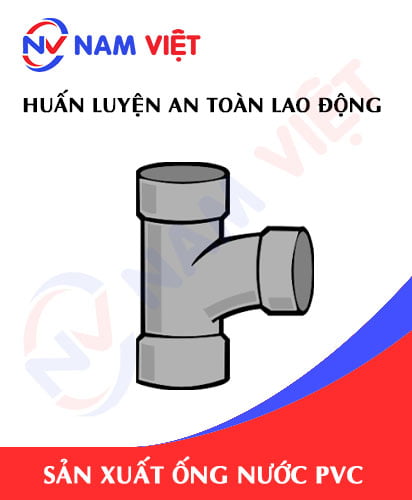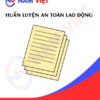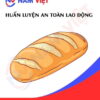Occupational Safety Training for PVC Pipe Manufacturing
99,000 ₫
Note: The above price is calculated for one person, the price may fluctuate depending on the number of trainees participating in the course and the market movement. For more accurate price support, please refer to the price list or contact our consulting staff directly.
Occupational safety is an important issue in factory manufacturing PVC pipes and needs to be addressed promptly to ensure the health and safety of workers, enhancing the reputation of businesses. The Occupational Safety Training course is one of the effective solutions to raise awareness of how to prevent occupational accidents for workers participating in PVC pipe manufacturing.
Table of Contents
Toggle1. Overview of PVC pipe industry
a. What is a PVC pipe?
- PVC pipe is a type of pipe made from PVC (Polyvinyl Chloride). This is a common type of pipe with a wide range of applications in daily life, from installing water supply systems, drainage systems, electrical systems, ventilation systems, to applications in industry, agriculture, and construction. PVC pipes have high durability, good abrasion resistance, easy installation and maintenance, good flexibility, can withstand high water pressure, low cost, and are environmentally friendly.
- Currently, the PVC pipe manufacturing industry in Vietnam is developing strongly. According to the General Statistics Office of Vietnam, the production output of PVC pipes in 2020 reached about 760,000 tons, an increase of nearly 10% compared to 2019. Notable PVC pipe manufacturing companies in Vietnam include Tan A Dai Thanh, Binh Minh Plastics, Viglacera, Viet Huong, Tan Viet, An Phat, Tien Phong Plastic, Long Truong, etc. However, the industry still faces many challenges, mainly from price and quality competition from regional and international rivals.

b. Machinery for PVC pipe manufacturing
The machinery for manufacturing PVC pipes includes:
- PVC resin mixer: Used to mix PVC resin pellets with additives, stabilizers, colorants, fillers, etc., to create a suitable PVC mixture for pipe manufacturing.
- PVC pipe extrusion machine: This machine feeds the PVC mixture into a pipe mold under high pressure and temperature to form PVC pipes.
- PVC pipe surface smoothing machine: Used to process the surface of PVC pipes after extrusion to make it smooth and uniform.
- PVC pipe cutting machine: Cuts PVC pipes to the required length and thickness.
- PVC pipe printing machine: Prints necessary information on the PVC pipe surface, such as manufacturer, pipe size, etc.

c. Typical PVC pipe manufacturing companies
Some typical PVC pipe manufacturing companies in Vietnam include:
- Tan Tien Plastic Company Limited: a leading company in producing and supplying PVC pipes. With over 20 years of experience, the company has built a strong reputation in the market.
- Binh Minh Plastic Industry Company Limited: established in 1996, specializes in producing plastic products, including PVC pipes. With modern machinery, the company meets customer demands nationwide.
- Tan A Dai Thanh Joint Stock Company: one of the pioneers in PVC pipe manufacturing in Vietnam. With quality-assured production processes, it has gained trust from domestic and international customers.
- Le Minh Plastic Company Limited: specializes in manufacturing and supplying plastic products, including PVC pipes. With an experienced and skilled team, the company ensures high-quality products and services.
- Minh Chau Plastic Pipe Joint Stock Company: specializes in producing PVC pipes, PPR pipes, and other plastic products. With modern equipment and quality-assured processes, the company has a solid position in the Vietnamese plastic market.
d. Specific jobs in PVC pipe manufacturing factories
Group 1
- CEO, Deputy CEO, department heads in PVC pipe manufacturing factories.
Group 2
- Safety officer: manages safety in the factory, designs safety procedures, supervises and ensures employees follow safe working procedures.
Group 3
- Raw material preparation: Includes PVC resin, fillers, stabilizers, colorants, and other chemicals.
- Mixing: Materials are fed into the mixer to blend all components evenly.
- Extrusion: The PVC mixture is extruded to form PVC sheets.
- Pipe cutting: Sheets are cut into desired lengths to form PVC pipes.
- Pipe blowing: Pipes pass through a pipe blowing machine to melt and shape them into different sizes and thicknesses.
- Quality inspection: Pipes are checked for dimensions, thickness, durability, and aesthetics.
- Packing and transportation: Pipes are packed and shipped to distributors or end customers.
Group 4
- Office work, service, sales, marketing.
- Production management, quality management, HR management, material management, finance and accounting.
- Research and development of new products, packaging and design.

2. Overview of PVC pipe manufacturing safety training
In this article, we focus on Group 3 because Group 3 directly participates in production and bears the highest occupational safety risk. See other groups here.
a. What is Group 3 Occupational Safety Training?
- Group 3 Occupational Safety Training equips workers with awareness of accident prevention in the workplace.
- The training helps workers recognize and avoid hazards, reducing the risk of accidents during work.
REGISTER FOR OCCUPATIONAL SAFETY TRAINING
b. Training duration
Initial safety training
- Total training time is at least 24 hours, including exams.
- 8 hours theory on safety and labor hygiene laws and policies
- 8 hours theory on basic occupational safety knowledge
- 4 hours theory on specialized training content
- 2 hours practical training on specialized content
- 2 hours final theory test
The safety training center organizes multiple sessions depending on workers’ schedules, usually 6 sessions over 3 days if continuous attendance is possible.
Periodic safety training
- Before the occupational safety card expires, workers must undergo periodic occupational safety training with at least 50% of the initial training time.
Explanation: periodic training lasts at least 12 hours, including tests. After completing the course and passing the exam, workers will receive renewed safety cards.
c. Training content
| No. | TRAINING CONTENT | TRAINING TIME (HOURS) | |||
| Total | Including | ||||
| Theory | Practice | Exam | |||
| I | Safety and labor hygiene laws and policies | 8 | 8 | 0 | 0 |
| 1 | Overview of legal documents on occupational safety and hygiene. | 6 | 6 | ||
| 2 | System of safety and labor hygiene standards. | 1 | 1 | ||
| 3 | Specific regulations of state management agencies regarding new construction, expansion, or renovation of facilities for manufacturing, using, storing, and inspecting machinery, equipment, materials, and substances requiring strict occupational safety and hygiene. | 1 | 1 | ||
| II | Basic occupational safety knowledge | 8 | 8 | 0 | 0 |
| 1 | Basic knowledge about hazards and harmful factors at the workplace. | 4 | 4 | ||
| 2 | Methods to improve working conditions. | 1 | 1 | ||
| 3 | Safety culture in production and business. | 1 | 1 | ||
| 4 | Rights and obligations of employers and workers; occupational safety policies for workers; functions of safety and hygiene staff. | 1 | 1 | ||
| 5 | Occupational safety regulations, signs, instructions, use of safety equipment and personal protective equipment; first aid skills, occupational disease prevention. | 1 | 1 | ||
| III | Specialized training content | 6 | 4 | 2 | 0 |
| Knowledge about machines, equipment, substances producing hazards; risk assessment and management; safe working procedures with machines and substances requiring strict safety and hygiene standards. | 6 | 4 | 2 | ||
| IV | Final safety training test | 2 | 2 | 0 | 0 |
| Total | 24 | 22 | 2 | ||
See more training content of all 6 groups
d. Occupational safety card
After completing the safety training and passing the exam, workers will receive a Group 3 Occupational Safety Card (commonly known as Group 3 Safety Certificate).
The card shows personal details: full name, birthdate, job, workplace, training duration, red stamp, and signature confirming completion.
According to Clause 2, Article 24, Decree 44/2016/ND-CP there are two cases:
- If the worker has a labor contract with the employer, the employer must sign, stamp, and certify the Group 3 card after the worker completes training and passes the exam.
- If the worker is freelance or temporary with no labor contract, the training unit must sign, stamp, and certify the card after completion and passing the exam.

3. Identifying Hazards in PVC Pipe Manufacturing
Some hazards in the process of manufacturing PVC pipes include:
- Health risks to workers from inhaling dust and toxic fumes from chemicals and lubricants during manufacturing.
- Occupational safety hazards due to machinery not being regularly maintained, working in high temperature and high pressure environments, and structural collapse risks.
- Fire and explosion risks if raw materials and chemicals used in manufacturing are not properly stored or handled.
- Health risks to workers if personal protective equipment is not fully used during manufacturing, including safety glasses, gloves, helmets, and safety shoes.
- Food safety hazards if PVC pipes are not manufactured according to proper procedures and stored correctly, causing contamination of the water supply.
4. Common Occupational Accidents in PVC Pipe Manufacturing
Common types of occupational accidents in PVC pipe manufacturing may include:
- Electric shock accidents: Since PVC pipe manufacturing involves the use of electrical machinery, there is a risk of electric shock or fire if safety procedures are not followed.
- Chemical accidents: The manufacturing process may involve hazardous chemicals, such as additives or cleaning agents, posing risks to health and occupational safety.
- Machinery-related accidents: Using large, complex machinery in the manufacturing process can lead to accidents such as eye burns or broken limbs.
- Accidents during product transportation: Transporting raw materials and finished PVC pipes to destinations may involve traffic accident risks, especially with large trucks.
- Heat-related accidents: High temperatures during PVC pipe production may cause burns if safety procedures are not followed.
- Accidents from improper use of protective equipment: Improper use of gloves, safety glasses, or masks can lead to occupational accidents such as burns or scalds.

5. Safety Measures in PVC Pipe Manufacturing
Safety measures when participating in PVC pipe manufacturing include:
- Providing employees with protective equipment such as safety glasses, masks, helmets, and gloves when working in dusty and noisy environments.
- Training employees in occupational safety skills and risk management in PVC pipe manufacturing, including techniques for using protective equipment.
- Using safe chemicals and minimizing the use of hazardous substances during production.
- Using safety devices such as fire alarms, fire extinguishers, gas clamps, and air filters to reduce the risk of fire, electric accidents, and other hazards.
- Ensuring a clean and safe working environment, meeting hygiene standards during production, and minimizing environmental contamination risks.
- Ensuring safety during transportation and storage of PVC pipes, storing in ventilated areas away from direct sunlight and heat sources, and safely handling heavy or sharp objects.
- Regularly inspecting, maintaining, and repairing machinery in the PVC pipe factory to ensure safe and stable operation, reducing accident risks.
- Adjusting pressure and temperature during PVC pipe production to suit workers.
- Periodically conducting occupational environment monitoring in factories, collecting and analyzing harmful factors, and adjusting to reduce risks to prevent occupational diseases.
6. Benefits of Occupational Safety Training in PVC Pipe Manufacturing
An Toan Nam Viet provides your business with the following benefits after completing occupational safety training courses in accordance with Decree 44/2016/ND-CP on occupational safety and hygiene for companies, factories, and enterprises:
- Workers can identify potential occupational hazards and take preventive measures to avoid accidents.
- Your business can establish risk prevention measures in production, operation, and maintenance processes.
- Reduce costs associated with occupational safety risks.
- Uninterrupted production improves labor productivity and product quality.
- Comply with labor safety laws and avoid legal risks.
- Enhance credibility and professionalism, thereby elevating your brand image.
Nam Viet’s training courses are a solution to prevent external factors from affecting individuals, helping them avoid dangers that could lead to injuries or worse, fatalities.
REGISTER FOR OCCUPATIONAL SAFETY TRAINING SERVICE
7. Customer Feedback After Completing PVC Pipe Manufacturing Safety Training
An Toan Nam Viet has many years of experience accompanying businesses in Vietnam, especially in southern provinces. This responsibility is very valuable to Nam Viet, so our Occupational Safety Training programs are increasingly professional. The motivation for Nam Viet’s growth comes from positive feedback and suggestions from businesses. Below are testimonials from partners we have served.
Bac Nam E&C Investment and Construction Joint Stock Company
“My first experience with An Toan Nam Viet’s service was surprising due to 24/7 support from the consulting team. The class organization was quick and convenient for our company. Thank you very much for Nam Viet’s service!”
Hoa Dat Construction and Trading Joint Stock Company
“Nam Viet’s service greatly helped us simplify occupational safety and complete safety documentation for work processes. The consulting team answered our questions promptly and enthusiastically. Five stars for Nam Viet.”
See more customer interviews after using the service of An Toan Nam Viet
8. An Toan Nam Viet’s Occupational Safety Training Capacity
An Toan Nam Viet is a leading and reputable center for occupational safety training in Vietnam. Our training sessions are continuously held at factories, production workshops, and construction sites nationwide (all 63 provinces in Vietnam).
REGISTER FOR OCCUPATIONAL SAFETY TRAINING SERVICE
Occupational Safety Training License
- An Toan Nam Viet has been inspected and certified by the Department of Safety of the Ministry of Labor – Invalids and Social Affairs and issued a certificate of eligibility for occupational safety and hygiene training, strengthening our training capabilities.

Training Materials and Lectures
- Before being used in occupational safety training courses, training materials are reviewed to ensure accuracy and effective knowledge transfer.
- Teaching methods are standardized according to An Toan Nam Viet standards, developed by experts in occupational safety and hygiene training to maximize knowledge absorption for trainees.
Facilities
- Controlling classroom factors affecting training increases teaching efficiency and knowledge retention.
- Our training facilities include spacious classrooms meeting standards for area, lighting, and training equipment.
9. Nationwide Reputable Occupational Safety Training Center
At An Toan Nam Viet, we prioritize professionalism in occupational safety training. Our goal is to equip workers with self-protection knowledge to ensure safety in their work life, contributing to national development.
To ensure effective training, we meticulously prepare every detail, from teaching tools and equipment to curricula, documents, sound, and lighting.
Our instructors are experts with years of experience and research on hazard identification and prevention across various industries. Lessons are practical, engaging, and easy to understand, helping workers comfortably absorb knowledge. All training aligns with Decree 44/2016/ND-CP.
Our training center proudly offers professional and reliable occupational safety services with advantages such as:
- Competitive training costs without compromising quality.
- Flexible scheduling according to company production needs.
- Quick and compliant certification procedures.
- Experienced instructors.
- Classrooms optimized for learning efficiency and knowledge retention.
- Lessons tailored to occupational safety needs of businesses.
- Dedicated, professional service for fast and accurate support.

10. Additional References for PVC Pipe Manufacturing Safety Training
- PVC Pipe Manufacturing Safety Training Materials
- Complete Occupational Safety Training Materials
- Occupational Safety Training Test Materials
- PVC Pipe Manufacturing Safety Quiz
- Slides for PVC Pipe Manufacturing Safety Training
1 review for Occupational Safety Training for PVC Pipe Manufacturing
No comments yet















namchinh.haiphong341
Dịch vụ tốt!!!